Category C – Road closed warnings
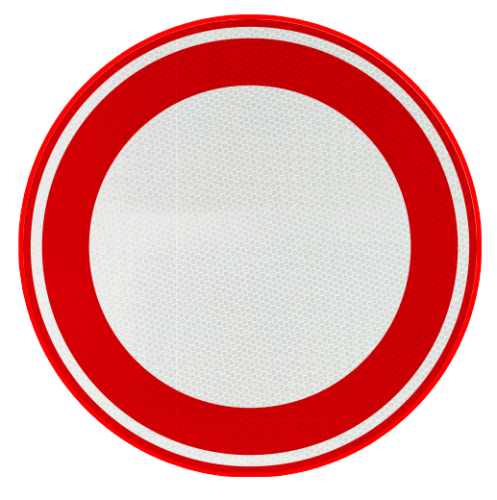 Sign C1 – Road closed in both directions to vehicles, riders and persons in charge of animals or livestock
Sign C1 – Road closed in both directions to vehicles, riders and persons in charge of animals or livestock
In the case of this sign, the legal text actually says it all. Drivers are not allowed to enter this road from either side. If you see a sign like this, you can assume that the same sign is on the other side of the road. This sign is sometimes accompanied by a sub-sign stating between which times this sign applies. For example, a road where a market is held. At the time of the market, it is then not allowed to enter this road.
If the sign is used for temporary closures, it must also be placed on the right side of the road on the verge, in addition to, for example, the fences forming the barrier. This is because fences can be moved and then there would no longer be a sign.
As the road is closed in both directions, no vehicles should be parked here. If this is still the case, you can be fined for this. You do not have to be found to have entered the road, as “using” the road is not allowed.
You are also not allowed to enter this road with a bicycle, moped, motorcycle or other vehicle. This is because the road is closed to vehicles.
Without a vehicle in hand, you may enter this road.
Various exceptions may apply to this sign. Some examples are:
- “except destination traffic”. “Uitgezonderd bestemmingsverkeer” in Dutch.
- excepting certain vehicle categories such as cyclists, mopeds, agricultural vehicles, passenger cars, police vehicles, lorries and buses.
- “excluding scheduled buses”.
- duration, e.g. “7-18 h”.
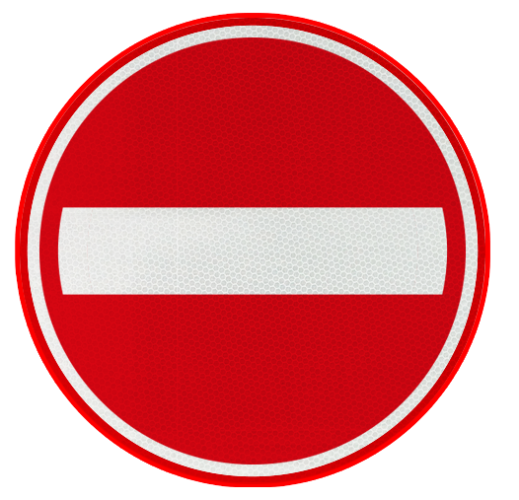 Sign C2 – One-way road, closed in this direction to vehicles, riders and persons in charge of animals or livestock.
Sign C2 – One-way road, closed in this direction to vehicles, riders and persons in charge of animals or livestock.
This road may only be entered from one direction and that is not this side. The only road users allowed to enter this road from this side are pedestrians. On the other side of the road, from where entry is allowed, is the C3 or C4 sign.
This sign is often found along canals. If a road is separated by water, you are allowed to enter it from both sides. However, this is not possible along most canals, as they are too narrow for two-way traffic.
To prevent ghost driving on motorways, these signs are placed along all slip roads. The sign then has an under sign saying “go back”.
By means of bottom plates, this sign can apply to certain categories of vehicles or certain categories can be exempted.
This sign is not applied at T-junctions, where application of sign C4, or D4 or D5 is possible. This is because you can already see the compulsory direction of travel from these signs.
This sign is not placed if it is clear from other signs or the situation that the road is closed in one direction. This occurs, for example, in a dual carriageway or lane junction with a narrow central reservation. In the case of a central reservation that is wider than 18 meters and in other dangerous situations, the sign is placed because of the danger of ghost driving.
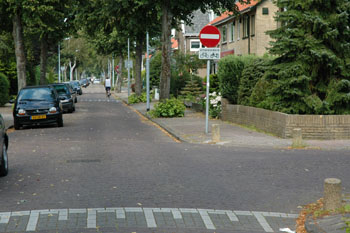
There is often limited one-way traffic. Cyclists and/or mopeds are then exempted and are allowed to enter this road. You can see this on the bottom plate by the text: Excluded with the images of a bicycle and/or moped.
Incidentally, other vehicles may also be exempt.
On the other side of the road, from where entry is permitted, you will see signs C3 or C4 with the same text on the bottom plate.
Drivers coming from a side road where this sign is placed often get in the far left lane. This means they are with you “earlier”. Bear this in mind.
 SIgn C3 – One-way road.
SIgn C3 – One-way road.
If this sign is placed, you should not expect oncoming drivers to arrive. However, always be wary because there could always be someone who, against the rules, enters the road from the other side anyway.
If you get in the left-hand lane to turn left, you generally do so on the far left.
Roads where this sign is placed are often narrow. There are therefore often parking bans.
On roads where this sign is posted, you may not turn or reverse. Reversing to park in a traffic jam is of course allowed.
There is often limited one-way traffic. Cyclists and/or mopeds are then exempted and are allowed to enter this road from the other side. You can see this on the bottom plate by the text: Excluded with the images of a bicycle and/or moped.
On the other side of the road, from where entry is permitted, you will then see a sign C2 with the same text on the bottom plate
Incidentally, other vehicles may also be exempted.
In all these cases, however, you must take into account oncoming traffic. On these roads, if you want to turn left, do not get in the full left-hand lane, but against the axis of the road. Otherwise, you may hinder drivers who want to enter this road.
 Sign C4 – One-way road.
Sign C4 – One-way road.
This sign is placed opposite the side road of a T-junction, if there is one-way traffic on the through road.
If this sign is posted, you need not expect oncoming drivers to arrive. However, always be on your guard because there could always be someone who will drive into the road from the other side against the rules anyway.
If you get in the left-hand lane to turn left, you generally do so on the far left.
Roads with this sign are often narrow. There are therefore often parking bans.
On roads with this sign, you are not allowed to turn or reverse. Reversing to park is of course allowed.
By means of subsidiary signs, this sign may apply to certain categories of vehicles or certain categories may be exempted. In that case, you must take into account oncoming traffic. If you want to turn left, you must get in lane against the road axis in these situations.
 Sign C5 – Entry permitted.
Sign C5 – Entry permitted.
It is allowed to enter this road. For many, this sign will be labelled unnecessary, because then you can put this sign on most roads. However, this sign is placed on roads where it is usually not clear at first whether you are allowed to enter. This is often the case when there are one or more lanes next to the roadway and it is not entirely clear whether you are allowed to enter the left-hand lane.
To avoid confusion with adjacent lanes, the sign may be placed on the left side of the road.
By a bottom plate, the sign may be declared applicable only to a certain category of road users. This then concerns certain vehicle categories such as mopeds, passenger cars, lorries and the like.
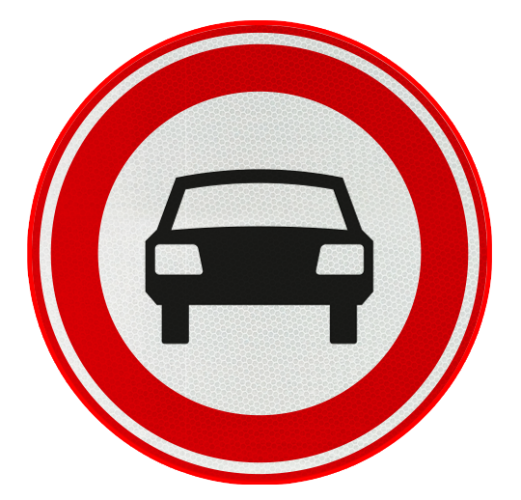 Sign C6 – Closed to motor vehicles with more than 2 wheels.
Sign C6 – Closed to motor vehicles with more than 2 wheels.
It is not allowed to enter this road with a motor vehicle on more than two wheels. The declaration of closure applies only to that side of the road where the sign is placed. From the other side it is then allowed to enter with a car.
The sign is often used in this way, especially on narrow roads.
Motorbikes are allowed to enter this road and they do.
For motorbikes with sidecar, however, the road is closed.
A motorbike with sidecar causes confusion. A motorbike with sidecar is a motor vehicle on more than two wheels.
A motorbike with a trailer does remain a two-wheeled motor vehicle.
When entering this road as a motorcyclist, be aware that oncoming drivers may mistakenly think that you are not allowed to enter this road.
Be mindful of motorists driving away. Chances are they are not expecting motorcyclists from your direction. Pay attention to drivers in parked vehicles and adjust your speed.
According to the RVV, the moped is a separate vehicle category, whose drivers must follow the rules of conduct for motor vehicles. This means that this road is also closed to mopeds.
When applying closed declarations, which are placed at one beginning of the road, action can only be taken against drivers entering or entering the road in question on that side. No action can then be taken against the use of the road under the closed declaration. After all, you can tell that you entered this road backwards from the other side.
 Sign C7 – Closed to lorries.
Sign C7 – Closed to lorries.
It is not allowed to enter this road with a lorry.
This sign is often placed in narrow and/or winding roads, or where local residents may be inconvenienced by lorry traffic. By car, bus or motorcycle, you are allowed to enter this road.
However, it is possible that lorries may come out of this road, as the sign only applies to the side of the road where it is placed.
Sometimes whole shopping areas or city centers are closed to lorries. This is then done by placing a zone sign.
Sometimes whole shopping areas or city centers are closed to lorries. This is done by placing a zone sign.
 Sign C7a – Closed for buses
Sign C7a – Closed for buses
It is not allowed to enter this road with a bus.
This sign is often placed in towns or villages where the town council does not want the presence of buses, or where local residents may be inconvenienced by buses. You may enter this road by car, lorry or on a motorcycle.
However, buses can come out of this road, as the sign only applies to the side of the road where it is placed.
Sometimes entire city centers are closed to buses. This is then done by placing a zone sign.
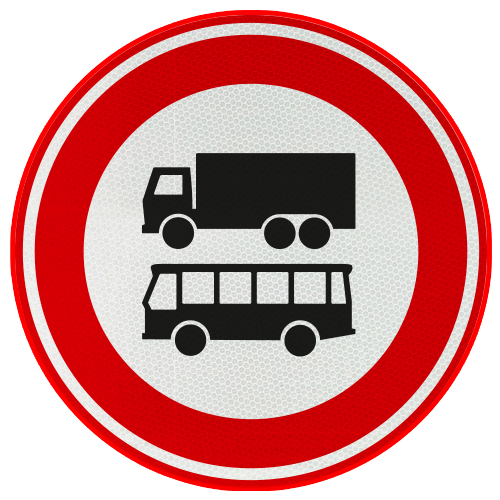 Sign C7b Closed for buses and lorries.
Sign C7b Closed for buses and lorries.
It is not allowed to enter this road with a bus or lorry.
This sign is often placed in narrow and/or winding roads, or where these vehicles may cause nuisance to local residents. You may enter this road by car or motorcycle.
However, buses or lorries can drive out of this road, as the sign only applies to the side of the road where it is placed.
Sometimes whole shopping areas or city centers are closed to buses and lorries. This is then done by placing a zone sign.
Through a bottom plate, it is possible to allow buses and lorries between certain times to stock shops.
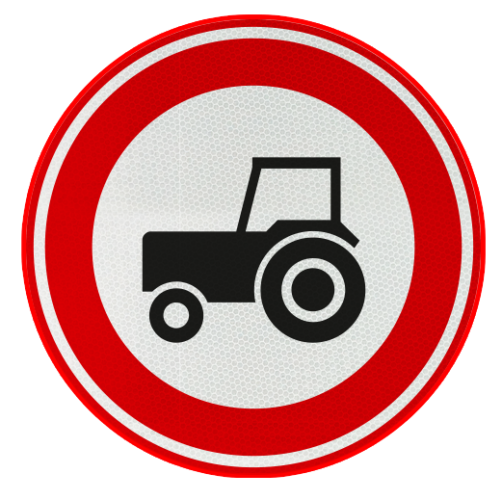 Sign C8 Closed to agricultural and forestry tractors, limited-speed motor carriages, and mobile machinery.
Sign C8 Closed to agricultural and forestry tractors, limited-speed motor carriages, and mobile machinery.
It is not permitted to enter such a road with a motor vehicle that cannot or may not drive faster than 40 kilometers per hour. This sign therefore does not apply to brommobielen. Brommobielen are allowed to drive a maximum of 45 kilometers per hour.
Also, the sign does not apply to snorfietsen and mopeds as they do not fall under the category of motor vehicles.
There is often a parallel road. Farmers will still need to reach their land.
This sign is often placed in agricultural areas. You will not encounter agricultural vehicles on this road, however, expect them on other roads in this area.
At junctions, watch out for slowly crossing agricultural vehicles and for sand or mud on the road.
This road is closed to this category only. Snorfietsen, mopeds, brommobielen, horse riders, lorries, and the like are allowed to enter this road
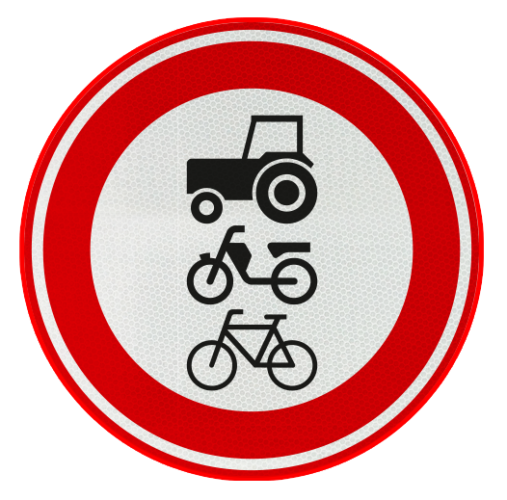 Sign C9 – Closed for horse riders, cattle, wagons, agricultural and forestry tractors, limited-speed motor carriages, mobile machinery, brommobielen, bicycles, snorfietsen, mopeds and vehicles for disabled persons.
Sign C9 – Closed for horse riders, cattle, wagons, agricultural and forestry tractors, limited-speed motor carriages, mobile machinery, brommobielen, bicycles, snorfietsen, mopeds and vehicles for disabled persons.
It is not allowed to use this road with any of the mentioned vehicles, cattle or horse riders. There is often an alternative road available for them. The road is therefore also closed to brommobielen.
This sign is used on roads where slow vehicles pose a danger or obstruct the traffic flow too much.
Also, this sign is often placed in agricultural areas. You will not come across agricultural vehicles on this road, perhaps on other roads in this area.
At junctions, watch out for slowly crossing agricultural vehicles and for sand or mud on the road.
This sign is particularly used on 80-kilometer roads with a fully closed statement outside built-up areas (the area access road). In all cases, this is then a priority road. This means that the sign is often combined with sign B1.
 Sign C10 – Closed for motor vehicles with trailers.
Sign C10 – Closed for motor vehicles with trailers.
It is not permitted to enter this road with a motor vehicle with a trailer. This also applies to brommobielen, and motorbikes with trailers.
If you tow a defective car with a car, the defective car is also a trailer at that time. You are therefore not allowed to enter this road in that case.
However, bicycles, snorfietsen, and mopeds may enter this road with a trailer.
This sign is often placed on narrower roads with few possibilities for avoiding traffic or with many bends.
When applying closed declarations, placed at one beginning of the road, action can only be taken against drivers entering or entering the road in question on that side. No action can then be taken against the use of the road under the closed declaration. After all, you can tell that you entered this road backward from the other side.
 Sign C11 – Closed for motorcycles.
Sign C11 – Closed for motorcycles.
It is not allowed to enter this road on a motorcycle, even if it is equipped with a sidecar or trailer.
These are often dyke roads that are closed to motorcycles because the motorbikes would cause a nuisance.
When applying closed declarations, placed at one beginning of the road, action can only be taken against drivers who enter or enter the road in question on that side. No action can then be taken against the use of the road under the closed declaration. After all, you can tell that you entered this road.
 Sign C12 – Closed to all motor vehicles.
Sign C12 – Closed to all motor vehicles.
The purpose of this sign is clear, no motor vehicles are allowed to enter this road here. Only bicycles and mopeds are tolerated here.
These signs are often placed in residential areas. If you come across such a sign as a cyclist or moped rider, bear in mind that children can often play here and that motor vehicles can approach from the other side.
When applying closed permits, which are placed at one end of the road, action can only be taken against drivers who enter the road concerned on that side. No action can then be taken against the use of the road under the closed declaration. After all, you can tell that you entered this road backwards from the other side.
Certain categories can be exempted by means of bottom plates.
 Sign C13 – Closed to snorfietsen, mopeds, and vehicles for disabled persons, with the engine running.
Sign C13 – Closed to snorfietsen, mopeds, and vehicles for disabled persons, with the engine running.
It is not permitted to enter this road with a snorfiets, moped, or vehicle for disabled persons, with the engine running. Brommobielen are allowed to enter this road.
This sign is often placed where there is a lot of other traffic, for example, many pedestrians and cyclists.
This sign is sometimes placed where many elderly people live. Preventing noise pollution is then the goal.
The sign is also placed near driveways to autowegen, and motorways. Moped riders are then directed over mandatory bicycle/moped paths, for fear that moped riders might accidentally enter the motorway.
 Sign C14 – Closed to bicycles and to vehicles for disabled persons, without the engine running.
Sign C14 – Closed to bicycles and to vehicles for disabled persons, without the engine running.
A road where this sign is posted is closed to cyclists and vehicles for disabled persons, without the engine running.
As snorfiets riders have to follow the rules for cyclists, snorfiets riders are not allowed to enter this road either.
There is usually a cycle path.
Mopeds are allowed to ride here, so keep this in mind.
 Sign C15 – Closed to bicycles, mopeds and vehicles for disabled persons.
Sign C15 – Closed to bicycles, mopeds and vehicles for disabled persons.
This road is closed to bicycles, snorfietsen, mopeds and vehicles for disabled persons. Brommobielen are allowed to enter this road.
This sign is often placed near shopping streets. It is dangerous to drive between shoppers.
This sign also occurs at points that can be dangerous for the vehicles themselves. This is where there are usually separate cycle/moped lanes.
 Sign C16 – Closed to pedestrians.
Sign C16 – Closed to pedestrians.
This sign is often placed where there is no footpath or pavement.
Due to the presence of fast-moving traffic, it is not safe to be a pedestrian here.
If you encounter breakdowns as a driver, bear in mind that other traffic is not expecting pedestrians here.
 Sign C17 – Closed to vehicles and combinations of vehicles that, including the load, are longer than indicated on the sign.
Sign C17 – Closed to vehicles and combinations of vehicles that, including the load, are longer than indicated on the sign.
The purpose of this sign is to prevent vehicles and/or composite vehicles (trailers) that, including the load, are longer than indicated on the sign. In this case, a maximum length of 10 meters applies.
This sign is usually placed in places where the road is not suitable for vehicles of such a length. These may be narrow roads with sharp turns that cannot be taken by a vehicle of this length.For example, buildings and other obstacles such as traffic lights and the like may be placed close to the roadway. This means that the vehicle has no room to move or can cause dangerous situations. Furthermore, lane narrowings can have the same effect.
Also, take bridges or viaducts in the area into account. As well as the possible presence of soft shoulders and crumbling sides of the roadway.
 Sign C18 – Closed to vehicles that, including the load, are wider than indicated on the sign.
Sign C18 – Closed to vehicles that, including the load, are wider than indicated on the sign.
The purpose of this sign is to exclude vehicles that, including the load, are wider than indicated on the sign. In this case, a maximum width of 2.3 meters applies.
This sign is usually placed in places where the road is not suitable for vehicles of such a width. These may be narrow roads with sharp bends that cannot be taken by a vehicle of this width. For example, buildings and other obstacles such as traffic lights and the like may be placed close to the roadway. This means that the vehicle has no room to move or can cause dangerous situations. Also, take bridges or viaducts in the area into account. As well as the possible presence of soft shoulders and crumbling sides of the roadway.
Road narrowings can also be a reason why this sign was placed. For example, a bridge that is narrower than the width on the board. Or flower boxes placed to make people drive more slowly.
During work in progress on motorways, the sign with a width restriction of 2 meters is placed as an image on sign L11. If the left lane is narrower than 3.00 meters, wide vehicles must be banned from the left lane.
 Sign C19 – Closed to vehicles that, including the load, are higher than indicated on the sign.
Sign C19 – Closed to vehicles that, including the load, are higher than indicated on the sign.
This sign indicates that the road is closed to vehicles that, including the load, are higher than indicated on the sign. In this case, the vehicle may not be higher than 3.1 meters.
This is because the bridge, viaduct, aqueduct, or tunnel does not offer passage to vehicles with a greater height than indicated on the sign.
This sign is also placed in case of temporary height restrictions, for example, work or pipelines above the road.
The number on the sign has one decimal place and is always 10 to 20 centimeters lower than the measured clearance height.
In addition, the number on the sign may not be greater than 3.9 m.
If the clearance height is higher, the information sign L1 can be used up to a maximum height on the sign of 4.40 meters.
The measured height is then 4.50 to 4.60 meters.
Sometimes a bottom plate indicates after how many meters this ban applies.
Another way is to warn about the object with the limited passage height by placing a portal with a hanging bar, which clearly warns vehicles that are too high about the restricted passage.
 Sign C20 – Closed to vehicles with an axle load higher than indicated on the sign.
Sign C20 – Closed to vehicles with an axle load higher than indicated on the sign.
This sign is usually placed on roads that are not suitable for vehicles with an axle load heavier than indicated on the sign.
These are usually roads that suffer damage, such as rutting, because they cannot properly support the weight of such a vehicle.
A shoulder that is far too soft, making it impossible to avoid oncoming traffic, can also be a reason for installation.
Furthermore, it may also be the case that the houses next to the road are too inconvenienced by passing vehicles;
vibrations that can lead to noise pollution or even damage to houses.
 Sign C21 – Closed to vehicles and combinations of vehicles, the total mass of which is higher than indicated on the sign.
Sign C21 – Closed to vehicles and combinations of vehicles, the total mass of which is higher than indicated on the sign.
This sign is usually placed on roads that are not suitable for vehicles, or vehicles with trailers with a heavier weight than indicated on the sign.These are usually roads that suffer damage, such as rutting, because they cannot properly support the weight of such a vehicle.
A shoulder that is far too soft, making it impossible to avoid oncoming traffic, can also be a reason for installation.
Furthermore, it may also be the case that the houses next to the road are too inconvenienced by passing vehicles; vibrations that can lead to noise pollution or even damage to houses.
 Sign C22 – Closed to vehicles containing certain hazardous substances.
Sign C22 – Closed to vehicles containing certain hazardous substances.
This sign is placed for tunnels. The transport of certain hazardous substances through tunnels is subject to restrictions.
Application and placement:
- The sign is placed at or in front of the entrance to tunnels referred to in the Regulations on land transport of dangerous substances.
- The sign is provided with a bottom plate, which indicates the category.
Preliminary designation: A preliminary indication in the form of sign L10 is placed on motorways and expressways.
Sign K14 can indicate which alternative route the vehicles mentioned should follow.
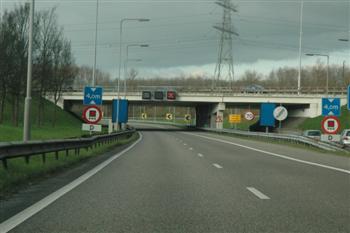
There are 5 categories of tunnels. The category of the tunnel is indicated on a bottom plate.
The categories are:
Category A: no restrictions on the transport of dangerous goods.
Category B: restrictions on dangerous goods that could lead to a very large explosion.
Category C: restrictions on dangerous goods that could result in a very large explosion, a large explosion, or the release of a large amount of toxic substances.
Category D: restrictions on dangerous goods, which could lead to a very large explosion, a large explosion, the release of a large amount of toxic substances, or a large fire.
Category E: Restrictions for all hazardous substances except UN numbers 2919, 3291, 3331, 3359 and 3373.
 C22a – Closed to passenger and commercial cars, trucks, or buses with a diesel engine due to environmental zone.
C22a – Closed to passenger and commercial cars, trucks, or buses with a diesel engine due to environmental zone.
You come across these signs in more and more cities.
A bottom plate can indicate which vehicles may or may not enter this zone.
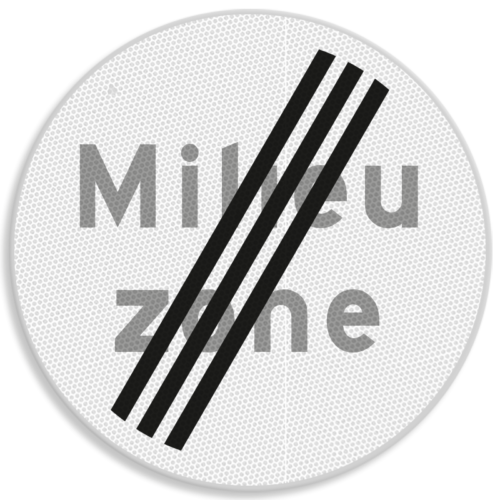 C22b – End of environmental zone declaration.
C22b – End of environmental zone declaration.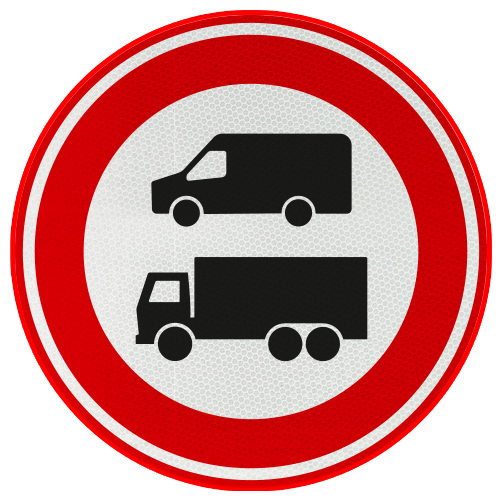 C22c – Closed to commercial vehicles and lorries due to zero emission zone.
C22c – Closed to commercial vehicles and lorries due to zero emission zone. C22c1 – Bottom sign at sign C22c: zero-emission zone accessible to zero-emission commercial vehicles and lorries.
C22c1 – Bottom sign at sign C22c: zero-emission zone accessible to zero-emission commercial vehicles and lorries.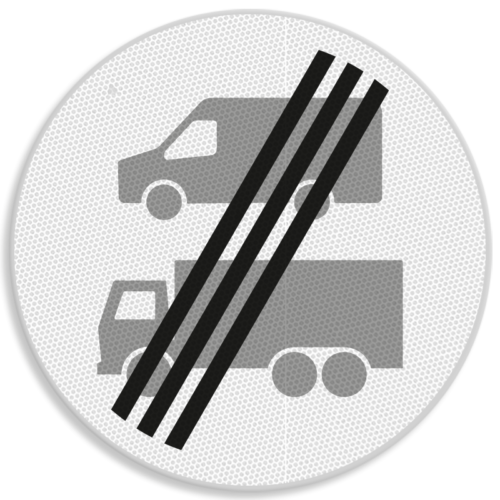 C22d – End of zero emission zone declaration.
C22d – End of zero emission zone declaration.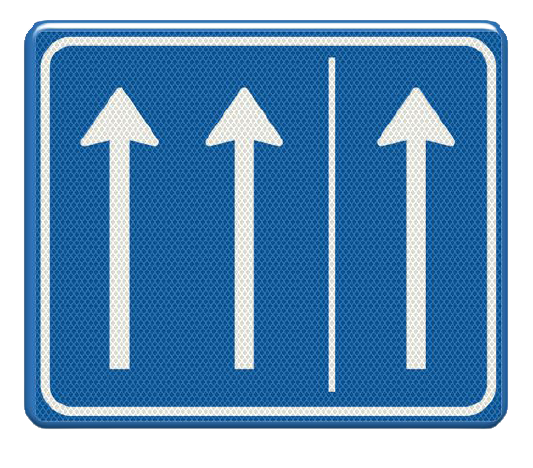 C23-01 Rush hour lane open.
C23-01 Rush hour lane open.
This sign is used on certain routes to indicate that an extra lane has been opened as a rush-hour lane due to heavy traffic, especially during rush hour.
This is usually the emergency lane on the right, but can also be on the left. If the rush-hour lane is open, you can also see this from the green arrows that light above the road surface.
You may then drive over the solid line to reach the rush-hour lane. During the opening of the rush hour lane, a lower maximum speed applies.
The number of white arrows shows how many lanes there are. The board can be provided with a bottom plate.
In that case, the text reads: “Speed-hour lane open”, in Dutch: “Spitsstrook open”.
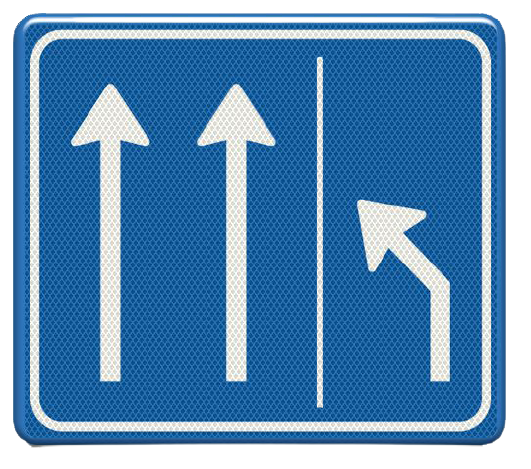 C23-02 – Clear rush-hour lane.
C23-02 – Clear rush-hour lane.
This sign is used to indicate that the rush-hour lane must be left.A so-called drift arrow will then appear above the road.
To clear the rush-hour lane, you may drive over the solid line.
The sign can be provided with a bottom plate.
In that case, the text reads: “Clear rush hour lane”, in Dutch: “Spitsstrook vrijmaken”.
Be aware of merging traffic when you see this sign.
Keep your distance and leave room for merging drivers.
Pay particular attention to drivers who want to merge at the last minute.
If you are driving in the rush hour lane: start merging in time.
So look, indicate direction, and merge if possible. Then immediately ensure a safe distance and take into account drivers who overtake on the right at the end and want to merge.
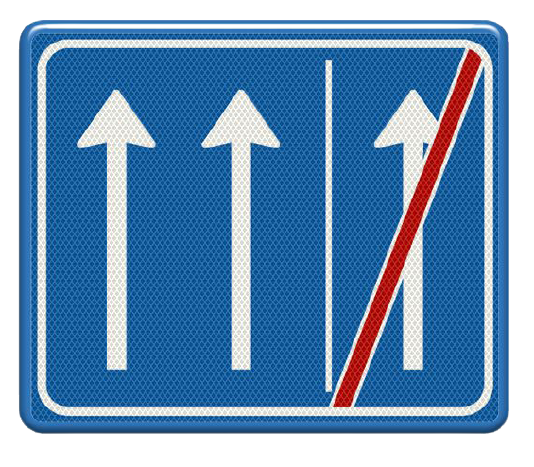 C23-03 – End of rush hour lane.
C23-03 – End of rush hour lane.